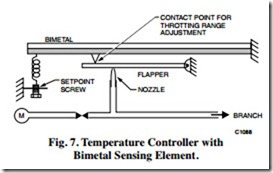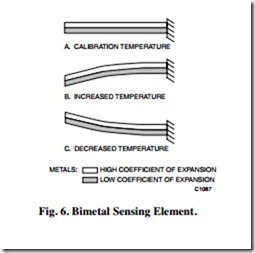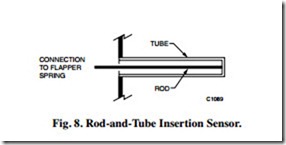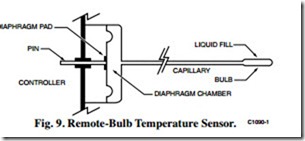SENSING ELEMENTS
BIMETAL
A bimetal sensing element is often used in a temperature controller to move the flapper. A bimetal consists of two strips of different metals welded together as shown in Figure 6A. As the bimetal is heated, the metal with the higher coefficient of expansion expands more than the other metal, and the bimetal warps toward the lower-coefficient metal (Fig. 6B). As the temperature falls, the bimetal warps in the other direction (Fig. 6C).
A temperature controller consists of a bimetal element linked to a flapper so that a change in temperature changes the position of the flapper. Figure 7 shows a direct-acting thermostat (branchline pressure increases as temperature increases) in which the branchline pressure change is proportional to the temperature change. An adjustment screw on the spring adjusts the temperature at which the controller operates. If the tension is increased, the temperature must be higher for the bimetal to diaphragm chamber. The expansion causes the diaphragm pad to push the pin toward the lever, which moves the flapper to change the branchline pressure.
The rod-and-tube sensing element consists of a brass tube and an Invar rod, as shown in Figure 8. The tube expands and contracts in response to temperature changes more than the rod. The construction of the sensor causes the tube to move the rod as the tube responds to temperature changes. One end of the rod connects to the tube and the other end connects to the flapper spring to change the force on the flapper.
On a rise in temperature, the brass tube expands and draws the rod with it. The rod pulls on the flapper spring which pulls the flapper closed to the nozzle. The flapper movement decreases the air-bleed rate, which increases branchline pressure.
REMOTE BULB
The remote-bulb sensing element has as measuring element made up of a capillary and bulb filled with a liquid or vapor (Fig. 9). On and increase in temperature at the bulb, the liquid or vapor expands through the capillary tubing into the
develop the force necessary to oppose the spring, lift the flapper, and reduce the branch pressure.
AVERAGING ELEMENT
The averaging-element sensor is similar to the remote-bulb sensor except that it has no bulb and the whole capillary is the measuring element. The long, flexible capillary has a slightly wider bore to accommodate the equivalent liquid fill that is found in a remote-bulb sensor. The averaging-element sensor averages temperatures along its entire length and is typically used to measure temperatures across the cross section of a duct in which two air streams may not mix completely. Averaging element sensors are used to provide an input signal to a controller.


